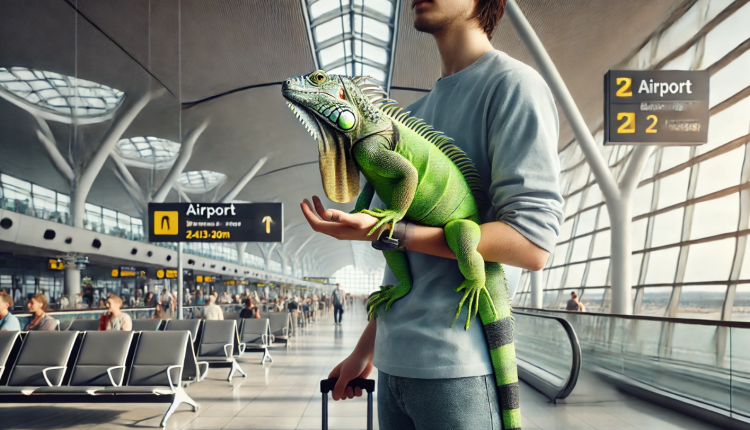Traveling with Reptiles: A Comprehensive Guide
Embarking on a journey with your reptilian companion requires meticulous planning and consideration to ensure their health, safety, and comfort. Unlike traditional pets, reptiles have unique environmental and dietary needs that must be maintained even during travel. This guide provides detailed insights into preparing for a trip with your reptile, selecting appropriate carriers, understanding transportation regulations, and ensuring your pet’s well-being throughout the journey.
Pre-Travel Preparation
Health Assessment and Veterinary Consultation
Before initiating any travel plans, it’s imperative to assess your reptile’s health:
- Veterinary Check-Up: Schedule a visit to a veterinarian experienced with reptiles to ensure your pet is in optimal health. This is particularly crucial for long journeys or when crossing state or international borders, as health certificates may be required.
- Health Certificates: Obtain any necessary documentation certifying your reptile’s health status. For international travel, specific certifications may be mandated by the destination country.
Researching Legal Requirements
Laws and regulations regarding the transport of reptiles vary by location:
- Permits and Licenses: Investigate whether special permits are needed to transport your reptile across state lines or into another country. Some species are protected under international laws, such as the Convention on International Trade in Endangered Species (CITES), and require specific documentation.
- Quarantine Regulations: Be aware of any quarantine periods that may be enforced upon arrival at your destination.
Choosing the Appropriate Travel Carrier
Selecting a suitable carrier is vital for your reptile’s safety and comfort:
- Size and Ventilation: The carrier should be appropriately sized, allowing your reptile to move slightly but not so large that they can be jostled during transit. Ensure adequate ventilation to maintain air quality.
- Security: The enclosure must be escape-proof, with secure latches and doors.
- Material: Opt for carriers made of durable, non-toxic materials that are easy to clean.
- Comfort: Line the bottom with appropriate substrate or padding to provide comfort and absorb waste.
Maintaining Environmental Conditions
Reptiles are ectothermic and rely on external sources to regulate their body temperature:
- Temperature Control: Use heat packs or portable heating devices to maintain the necessary temperature gradient within the carrier. Always monitor to prevent overheating.
- Humidity Levels: Depending on your reptile’s species, maintain appropriate humidity levels using dampened substrates or humidity packs.
- Lighting: While natural light exposure is beneficial, avoid direct sunlight on the carrier to prevent overheating.
Transportation Methods
Traveling by Car
- Placement: Secure the carrier in a stable position, away from airbags and direct sunlight.
- Climate Control: Use the vehicle’s heating or air conditioning to maintain appropriate ambient temperatures.
- Minimize Stress: Keep the environment calm by reducing loud noises and sudden movements.
Traveling by Air
Air travel with reptiles involves specific considerations:
- Airline Policies: Many airlines do not allow reptiles in the cabin but may permit them in the cargo hold. Contact the airline well in advance to understand their specific policies and requirements.
- Shipping Procedures: You may need to become a “known shipper” with the airline’s cargo department. This process involves pre-approval and adherence to specific packaging standards.
- Carrier Specifications: Use airline-approved shipping containers that meet size and ventilation requirements.
- Scheduling: Book direct flights to minimize handling and potential stress. Avoid extreme temperatures by choosing flights during appropriate times of the day and year.
Traveling by Train or Bus
- Carrier Acceptance: Confirm with the transportation company whether reptiles are permitted on board.
- Environmental Control: Ensure you can maintain necessary temperature and humidity levels during the journey.
In-Transit Care
- Regular Monitoring: Periodically check on your reptile to ensure they are comfortable and the environmental conditions remain stable.
- Feeding: It’s often advisable to avoid feeding your reptile immediately before and during travel to prevent regurgitation and reduce waste. Feed them well in advance and resume regular feeding once they’ve acclimated to the new environment.
- Hydration: Provide water as necessary, ensuring it doesn’t spill and cause unsanitary conditions. For species requiring higher humidity, misting may be appropriate.
Post-Travel Considerations
Upon reaching your destination:
- Habitat Setup: Promptly set up your reptile’s enclosure, replicating their familiar environment to reduce stress.
- Health Monitoring: Observe your reptile for any signs of stress or illness, such as changes in appetite or behavior.
- Acclimation Time: Allow your reptile time to adjust to the new surroundings before resuming regular handling or feeding routines.
Conclusion
Traveling with reptiles necessitates thorough preparation and an understanding of their unique needs. By ensuring proper health assessments, adhering to legal requirements, selecting suitable carriers, maintaining environmental controls, and providing attentive in-transit care, you can facilitate a safe and stress-free journey for your reptilian companion. Always prioritize your pet’s well-being and consult with professionals when planning travel to ensure all considerations are adequately addressed.

